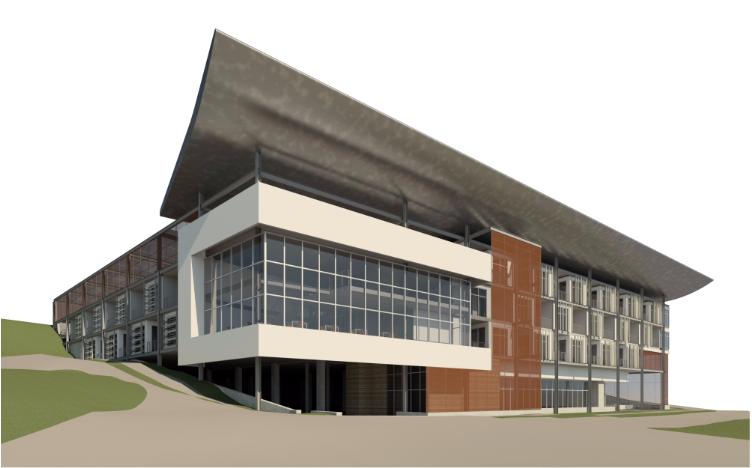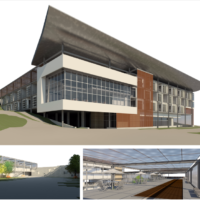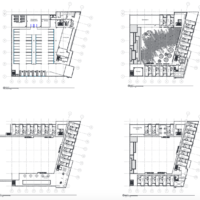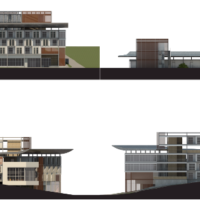To paraphrase the late, great Whitney Houston: “Today’s architecture students are senior housing’s future.”
And, if the winning Student Exhibition entry in the 2016 Senior Housing News Design Awards is any indication, the future of senior housing design is research-driven, centrally located and cutting-edge.
This year’s winner was the brainchild of Willie Johnson, Kailey Smith, Louis Weishaar and Hannah Wobbe, all graduate students at The University of Kansas (KU). The students’ technologically advanced re-design of current KU faculty retirement housing wowed Perkins Eastman Principal and Executive Director Dan Cinelli—who, as a 2016 Senior Housing News Design Awards judge, assured SHN that the group’s ultra-futuristic design isn’t that far-fetched.
“If you were looking at this, you’d go, wow, is this real?” Cinelli says. “It is.”
The More Technology, the Better
Johnson, Smith, Weishaar and Wobbe dreamt up their senior housing design as part of a studio class taught by Joe Colistra, an associate professor at KU. A few months ago, Colistra tasked his students with hypothetically redesigning and adding onto Sprague Hall, a 10-unit building near campus that currently houses retired university faculty.
Technology would have to play a critical role in the students’ final design, Colistra stressed. The students took that to heart.
“We wanted to use new technologies to make indendent living more possible for the aging population,” Wobbe explains to SHN. “In the case of Sprague Hall, it’s just outdated in terms of tech and systems in place.”
When it came to embracing technology, the students delivered: they incorporated gait-analysis sensors in the floors, smart toilets that monitor hydration levels in the bathrooms, sensor-integrated beds that monitor sleep patterns in the bedrooms, medicine dispensers that sort pills, and more.
“The thing that stuck out foremost was the integration of technology into the design,” John Cronin, principal at AG Architecture and a 2016 SHN Design Awards judge, tells SHN. “It was all neat to see that because I’ve been reading enough about it, but I’ve never seen anyone trying to implement it all in one project.”
All of this technology doesn’t come cheap, however. Realizing this, the students also incorporated what they call a “living lab” on the ground floor of the hypothetical community, where college-age researchers could analyze all of the data being gathered upstairs.
“The living lab is square footage that could be rented out to the university,” Colistra explains. “By having a university center renting that living lab out, that would subsidize the housing above.”
Next to the living lab, there’s a community coffee shop and a cafeteria, envisioned as places where residents can go when they don’t want to cook for themselves. Together, these three spaces have the added bonus of making residents feel closely linked to their younger neighbors.
“If you were retired faculty, you’d still feel like you were in the middle of the campus,” Cinelli says. “You could still feel like you’re connected.”
The students’ decision to go the tech-savvy route also ultimately influenced their design of the building’s exterior.
“It didn’t seem appropriate to put state-of-the-art tech into a building that’s trying to look like it was built 100 years ago,” Colistra explains.
Consequently, the exterior design features several cool colors and clean, straight lines.
Just because residents are getting up there in age, doesn’t mean their living space should reflect that, Cinelli adds.
“It’s not your grandfather’s retirement community that looks like a country club,” Cinelli says. “They were respectful of how retired faculty could be in a very modern-looking building.”
Sparking Students’ Interest
With the right approach, it won’t be too much of an uphill battle to convince young architects to go into senior housing—especially as senior housing spreads to more urban areas, Colistra suggests. Still, some rumors may have to be addressed.
“I think that a lot of students maybe have preconceived notions about what senior living architecture is about,” Cinelli says. “For them, it’s more like health care.”
To put it plainly, senior housing is “real-world architecture,” Cronin says. That’s because, with 10,000 baby boomers turning 65 every day, senior housing is only going to get more common in years to come.
This fact is not lost on students like Johnson.
“This is not a problem that’s going to disappear within the next five, 10, 15 years,” Johnson tells SHN.
Colistra agrees.
“The demand is obviously exploding,” Colistra says. “I think everyone sees the lack of appropriate housing as an oncoming crisis.”
Written by Mary Kate Nelson





